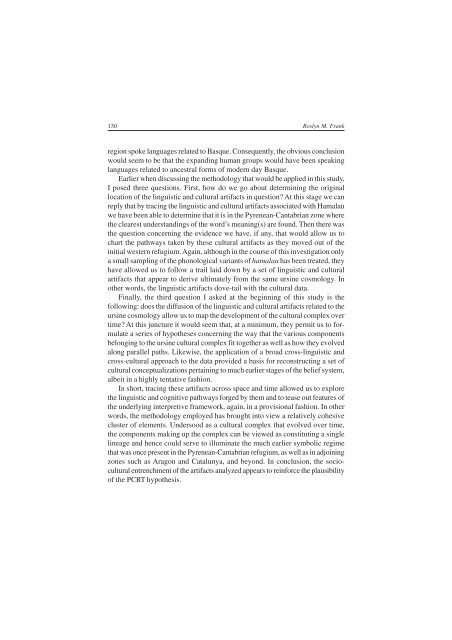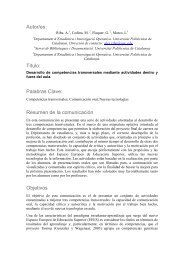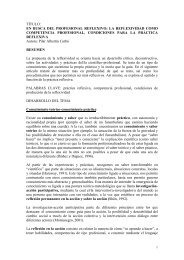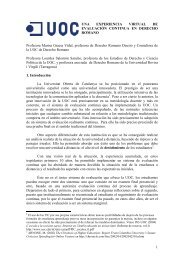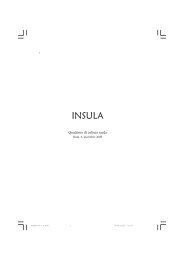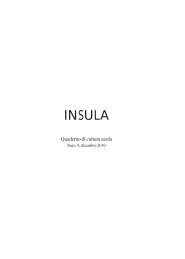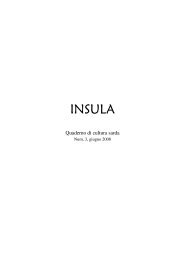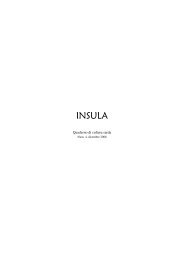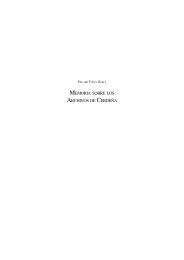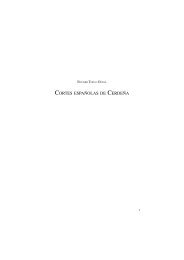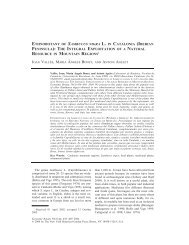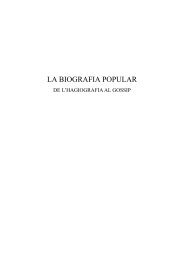Impaginato 5.p65 - Universitat Rovira i Virgili
Impaginato 5.p65 - Universitat Rovira i Virgili
Impaginato 5.p65 - Universitat Rovira i Virgili
You also want an ePaper? Increase the reach of your titles
YUMPU automatically turns print PDFs into web optimized ePapers that Google loves.
130<br />
Roslyn M. Frank<br />
region spoke languages related to Basque. Consequently, the obvious conclusion<br />
would seem to be that the expanding human groups would have been speaking<br />
languages related to ancestral forms of modern day Basque.<br />
Earlier when discussing the methodology that would be applied in this study,<br />
I posed three questions. First, how do we go about determining the original<br />
location of the linguistic and cultural artifacts in question? At this stage we can<br />
reply that by tracing the linguistic and cultural artifacts associated with Hamalau<br />
we have been able to determine that it is in the Pyrenean-Cantabrian zone where<br />
the clearest understandings of the word’s meaning(s) are found. Then there was<br />
the question concerning the evidence we have, if any, that would allow us to<br />
chart the pathways taken by these cultural artifacts as they moved out of the<br />
initial western refugium. Again, although in the course of this investigation only<br />
a small sampling of the phonological variants of hamalau has been treated, they<br />
have allowed us to follow a trail laid down by a set of linguistic and cultural<br />
artifacts that appear to derive ultimately from the same ursine cosmology. In<br />
other words, the linguistic artifacts dove-tail with the cultural data.<br />
Finally, the third question I asked at the beginning of this study is the<br />
following: does the diffusion of the linguistic and cultural artifacts related to the<br />
ursine cosmology allow us to map the development of the cultural complex over<br />
time? At this juncture it would seem that, at a minimum, they permit us to formulate<br />
a series of hypotheses concerning the way that the various components<br />
belonging to the ursine cultural complex fit together as well as how they evolved<br />
along parallel paths. Likewise, the application of a broad cross-linguistic and<br />
cross-cultural approach to the data provided a basis for reconstructing a set of<br />
cultural conceptualizations pertaining to much earlier stages of the belief system,<br />
albeit in a highly tentative fashion.<br />
In short, tracing these artifacts across space and time allowed us to explore<br />
the linguistic and cognitive pathways forged by them and to tease out features of<br />
the underlying interpretive framework, again, in a provisional fashion. In other<br />
words, the methodology employed has brought into view a relatively cohesive<br />
cluster of elements. Undersood as a cultural complex that evolved over time,<br />
the components making up the complex can be viewed as constituting a single<br />
lineage and hence could serve to illuminate the much earlier symbolic regime<br />
that was once present in the Pyrenean-Cantabrian refugium, as well as in adjoining<br />
zones such as Aragon and Catalunya, and beyond. In conclusion, the sociocultural<br />
entrenchment of the artifacts analyzed appears to reinforce the plausibility<br />
of the PCRT hypothesis.


